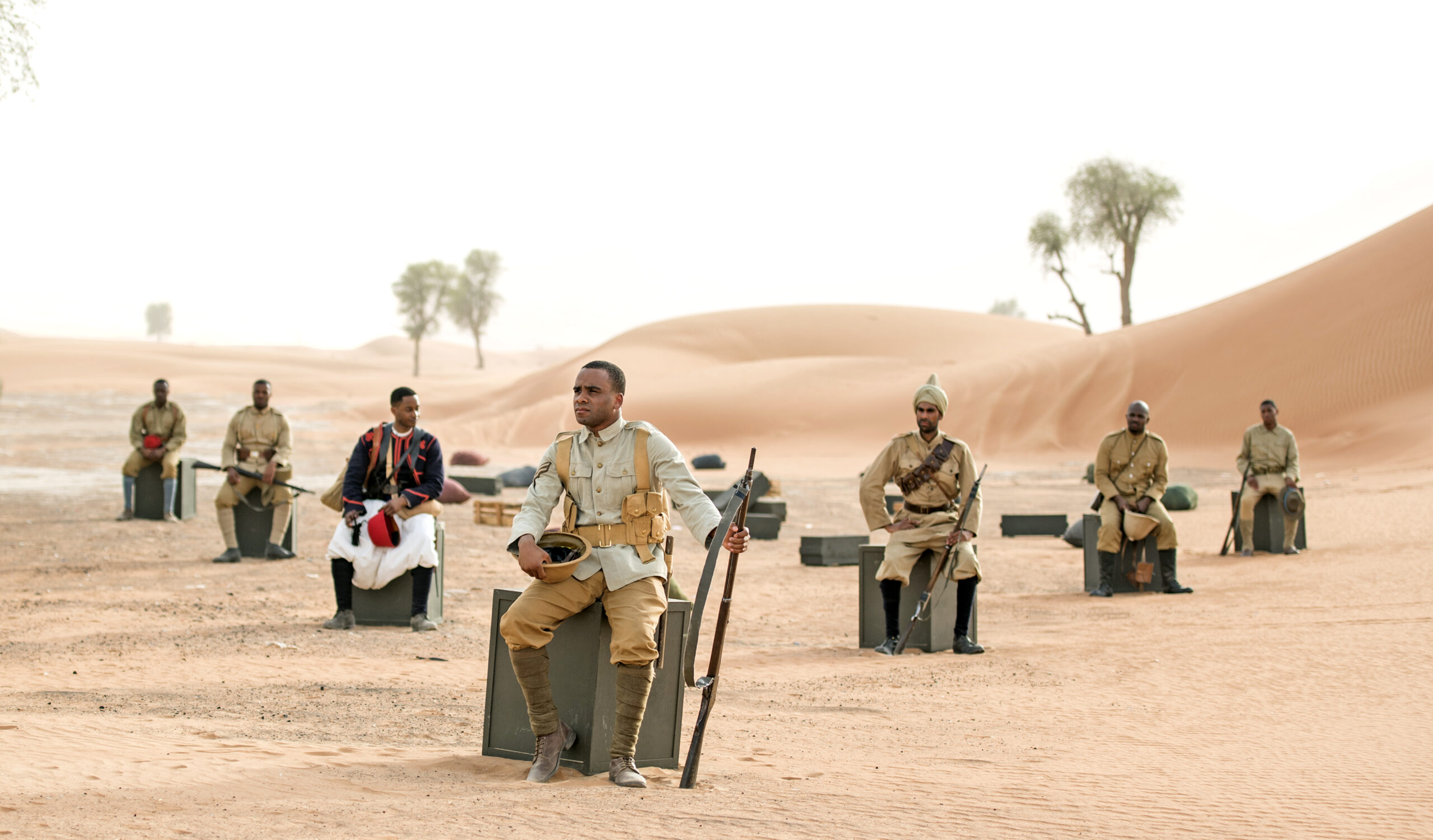1 October 2022 - 8 January 2023 at Bristol Museum & Art Gallery
John Akomfrah - Mimesis: African Soldier
Mimesis: African Soldier by John Akomfrah is a three-screen immersive video which assembles archive film footage of soldiers from around the Commonwealth as they enlist and train to fight the war of their colonial masters.
Using the careful collaging of footage whose aesthetic he has made his own, John Akomfrah blends archive imagery of African and Asian soldiers at work, digging trenches and fetching and carrying with imagined mises en scènes of the men departing and returning to their partners.
The imagery is overlaid with a poignant soundtrack including African and Indian song. Sparse captions form a commentary: ‘Six million African and other colonial subjects served in the Great War’, ‘Those who do not move do not notice their chains’ (Rosa Luxembourg), ‘disenchantment’, ‘scepticism’.
Throughout the film is imagery of water running over vintage photographs. Akomfrah paints a vivid cinematic portrait of a forgotten, or overlooked history.

“The most important thing for me, the takeaway, is that African soldiers fought in this war, that they played a variety of roles in the war as foot soldiers, as carriers. Every facet, every avenue, every job in the war, if you look long enough, you will see someone of either Asian or African origin/heritage in that role.”
‘Europe was a much bigger place’
There have been Black soldiers in the British army for over 300 years. Yet their presence has only recently been acknowledged in European history. During the centenary in 2014-18 of World War 1, historians uncovered the contribution made by soldiers from Africa, India and other parts of the British Empire.
Over 15,000 Black soldiers came to Europe from the Caribbean, joined by some 60,000 recruits from Bermuda and South Africa. A further 200,000 travelled from Egypt, India, Fiji, Mauritius and the Seychelles.
At first Black recruits were permitted to serve only on a non-combatant basis. They did the physical work: they carried munitions, dug trenches, laid cables, loaded shells, tended animals and constructed railways. Fighting alongside White Europeans was seen as undermining colonial rule. This changed as the War progressed.
Thousands of Africans also volunteered to serve in the Royal Navy.
In Nigeria, Gold Coast, Sierra Leone, Gambia, Uganda, Kenya and Somaliland soldiers were recruited to defend their countries – which had been colonised by the British – against the adjoining German colonial territories. This is just the countries colonised by Britain: there were also soldiers from countries colonised by France, Belgium and Germany.
“If you’re a West African in 1914, you’re from a colony. And if you came from a colony to fight in the War, that made no difference to your status as a colonial subject. You fought. If you were lucky to survive in 1918 you went back and nothing changed. You were in exactly the same space as before you left. Which goes against most of the reasons people fight!”
John Akomfrah
John Akomfrah was born in Ghana but his family fled the country after the coup in 1966 when he was a child. He grew up in Britain and after getting his sociology degree in 1982 he established the Black Audio Film Collective with Lina Gopaul and David Lawson. In 1997 he founded the production company Smoking Dogs, also with Gopaul and Davis.
Akomfrah has taught at universities overseas and was governor of the British Film Institute from 2001-2007 and Film London 2004-13. He was made an OBE in 2009 and CBE in 2017, the same year that he was awarded the Artes Mundi prize.
“We have obligations to the dead, historian Carlo Ginzburg once said. Honouring the untold sacrifices made by the many thousands of soldiers, labourers and carriers from a colonised Africa is an obligation. And I am proud to honour it.”
Acknowledgements
Presented by Art Fund and 14-18 NOW, the UK’s arts programme for the First World War centenary, to Bristol Museums and Glasgow Museums.
Commissioned by 14-18 NOW, with support from the National Lottery Heritage Fund, Arts Council England and the Department for Digital Culture, Media and Sport.